Ferroelastic Domain Boundary-Based Multiferroicity
Abstract
:1. Introduction
2. CaTiO3
3. SrTiO3
4. Domain Glass and Complex Structures
5. Conclusions
Acknowledgments
Author Contributions
Conflicts of Interest
References
- Daraktchiev, M.; Catalan, G.; Scott, J.F. Landau theory of domain wall magnetoelectricity. Phys. Rev. B 2010, 81, 224118. [Google Scholar] [CrossRef] [Green Version]
- Lajzerowicz, J.J.; Niez, J.J. Phase transition in a domain wall. J. Phys. Lett. 1979, 40, 165–169. [Google Scholar] [CrossRef]
- Wojdeł, J.C.; Íñiguez, J. Ferroelectric transitions at ferroelectric domain walls found from first principles. Phys. Rev. Lett. 2014, 112, 247603. [Google Scholar] [CrossRef] [PubMed]
- Salje, E.K.H. Multiferroic domain boundaries as active memory devices: Trajectories towards domain boundary engineering. Chemphyschem 2010, 11, 940–950. [Google Scholar] [CrossRef] [PubMed]
- Salje, E.K.H.; Zhang, H. Domain boundary engineering. Phase Transit. 2009, 82, 452–469. [Google Scholar] [CrossRef] [Green Version]
- Seidel, J.; Martin, L.W.; He, Q.; Zhan, Q.; Chu, Y.-H.; Rother, A.; Hawkridge, M.E.; Maksymovych, P.; Yu, P.; Gajek, M.; et al. Conduction at domain walls in oxide multiferroics. Nat. Mater. 2009, 8, 229–234. [Google Scholar] [CrossRef] [PubMed]
- Catalan, G.; Seidel, J.; Ramesh, R.; Scott, J.F. Domain wall nanoelectronics. Rev. Mod. Phys. 2012, 84, 119–156. [Google Scholar] [CrossRef] [Green Version]
- Schilling, A.; Byrne, D.; Catalan, G.; Webber, K.G.; Genenko, Y.A.; Wu, G.S.; Scott, J.F.; Gregg, J.M. Domains in ferroelectric nanodots. Nano Lett. 2009, 9, 3359–3364. [Google Scholar] [CrossRef] [PubMed]
- Farokhipoor, S.; Noheda, B. Conduction through 71 degrees Domain Walls in BiFeO3 Thin Films. Phys. Rev. Lett. 2011, 107, 127601. [Google Scholar] [CrossRef] [PubMed]
- Catalan, G.; Janssens, A.; Rispens, G.; Csiszar, S.; Seeck, O.; Rijnders, G.; Blank, D.H.; Noheda, B. Polar domains in lead titanate films under tensile strain. Phys. Rev. Lett. 2006, 96. [Google Scholar] [CrossRef] [PubMed]
- Viehland, D.D.; Salje, E.K.H. Domain boundary-dominated systems: Adaptive structures and functional twin boundaries. Adv. Phys. 2014, 63, 267–326. [Google Scholar] [CrossRef]
- Wang, D.W.; Salje, E.K.H.; Mi, S.B.; Jia, C.; Bellaiche, L. Multidomains made of different structural phases in multiferroic BiFeO3: A first-principles-based study. Phys. Rev. B 2013, 88, 134107. [Google Scholar] [CrossRef]
- Scott, J.F.; Salje, E.K.H.; Carpenter, M.A. Domain Wall Damping and Elastic Softening in SrTiO3: Evidence for Polar Twin Walls. Phys. Rev. Lett. 2012, 109. [Google Scholar] [CrossRef] [PubMed]
- Salje, E.K.H.; Safarik, D.J.; Modic, K.A.; Gubernatis, J.E.; Cooley, J.C.; Taylor, R.D.; Mihaila, B.; Saxena, A.; Lookman, T.; Smith, J.L.; et al. Tin telluride: A weakly co-elastic metal. Phys. Rev. B 2010, 82. [Google Scholar] [CrossRef]
- Seidel, J.; Maksymovych, P.; Batra, Y.; Katan, A.; Yang, S.Y.; He, Q.; Baddorf, A.P.; Kalinin, S.V.; Yang, C.H.; Yang, J.C.; et al. Domain Wall Conductivity in La-Doped BiFeO3. Phys. Rev. Lett. 2010, 105. [Google Scholar] [CrossRef] [PubMed]
- Aird, A.; Salje, E.K.H. Sheet superconductivity in twin walls: Experimental evidence of WO3-x. J. Phys. Condens. Matter 1998, 10, L377–L380. [Google Scholar] [CrossRef]
- Van Aert, S.; Turner, S.; Delville, R.; Schryvers, D.; Van Tendeloo, G.; Salje, E.K. Direct Observation of ferrielectricity at ferroelastic domain boundaries in CaTiO3 by electron microscopy. Adv. Mater. 2012, 24, 523–527. [Google Scholar] [CrossRef] [PubMed] [Green Version]
- Zykova-Timan, T.; Salje, E.K.H. Highly mobile vortex structures inside polar twin boundaries in SrTiO3. Appl. Phys. Lett. 2014, 104. [Google Scholar] [CrossRef] [Green Version]
- Yokota, H.; Usami, H.; Haumont, R.; Hicher, P.; Kaneshiro, J.; Salje, E.K.H.; Uesu, Y. Direct evidence of polar nature of ferroelastic twin boundaries in CaTiO3 obtained by second harmonic generation microscope. Phys. Rev. B 2014, 89. [Google Scholar] [CrossRef]
- Goncalves-Ferreira, L.; Redfern, S.A.; Artacho, E.; Salje, E.K. Ferrielectric twin walls in CaTiO3. Phys. Rev. Lett. 2008, 101. [Google Scholar] [CrossRef] [PubMed]
- Salje, E.K.H.; Aktas, O.; Carpenter, M.A.; Laguta, V.V.; Scott, J.F. Domains within Domains and Walls within Walls: Evidence for Polar Domains in Cryogenic SrTiO3. Phys. Rev. Lett. 2013, 111. [Google Scholar] [CrossRef] [PubMed]
- Salje, E.K.H.; Scott, J.F. Ferroelectric Bloch-line switching: A paradigm for memory devices. Appl. Phys. Lett. 2014, 105. [Google Scholar] [CrossRef]
- Bratkovsky, A.M.; Marais, S.C.; Heine, V.; Salje, E.K.H. The theory of fluctuations and texture embryos in structural phase transitions mediated by strain. J. Phys. Condens. Matter 1994, 6, 3679–3696. [Google Scholar] [CrossRef]
- Parlinski, K.; Heine, V.; Salje, E.K.H. Origin of tweed texture in the simulation of a cuprate superconductor. J. Phys. Condens. Matter 1999, 5, 497–518. [Google Scholar] [CrossRef]
- Aktas, O.; Salje, E.K.H.; Crossley, S.; Lampronti, G.I.; Whatmore, R.W.; Mathur, N.D.; Carpenter, M.A. Ferroelectric precursor behavior in PbSc0.5Ta0.5O3 detected by field-induced resonant piezoelectric spectroscopy. Phys. Rev. B 2013, 88. [Google Scholar] [CrossRef]
- Salje, E.K.H. Tweed, twins, and holes. Am. Mineral. 2015, 100, 343–351. [Google Scholar] [CrossRef]
- Aktas, O.; Carpenter, M.A.; Salje, E.K.H. Polar precursor ordering in BaTiO3 detected by resonant piezoelectric spectroscopy. Appl. Phys. Lett. 2013, 103, 2011–2015. [Google Scholar] [CrossRef] [Green Version]
- Kartha, S.; Krumhansl, J.A.; Sethna, J.P.; Wickham, L.K. Disorder-driven pretransitional tweed pattern in martensitic transformations. Phys. Rev. B 1995, 52, 803–822. [Google Scholar] [CrossRef]
- Salje, E.K.H.; Ding, X.; Aktas, O. Domain glass. Phys. Status Solidi 2014, 251, 2061–2066. [Google Scholar] [CrossRef] [Green Version]
- Salje, E.K.H.; Carpenter, M.A. Domain glasses: Twin planes, Bloch lines, and Bloch points. Phys. Status Solidi 2015, 252, 2639–2648. [Google Scholar] [CrossRef]
- Cross, L.E. Piezoelectricity; Springer: Berlin/Heidelberg, Germany, 2008; Volume 114, pp. 131–155. [Google Scholar]
- Viehland, D.; Wuttig, M.; Cross, L.E. The glassy behavior of relaxor ferroelectrics. Ferroelectrics 1991, 120, 71–77. [Google Scholar] [CrossRef]
- Kleemann, W. The relaxor enigma—Charge disorder and random fields in ferroelectrics. J. Mater. Sci. 2006, 41, 129–136. [Google Scholar] [CrossRef]
- Lloveras, P.; Castán, T.; Planes, A.; Saxena, A. Disorder and Strain-Induced Complexity in Functional Materials; Kakeshita, T., Fukuda, T., Saxena, A., Planes, A., Eds.; Springer: Berlin/Heidelberg, Germany, 2012; pp. 227–247. [Google Scholar]
- Salje, E.K.H.; Ding, X.; Zhao, Z.; Lookman, T. How to generate high twin densities in nano-ferroics: Thermal quench and low temperature shear. Appl. Phys. Lett. 2012, 100, 98–101. [Google Scholar] [CrossRef]
- Zubko, P.; Catalan, G.; Tagantsev, A.K. Flexoelectric Effect in Solids. Annu. Rev. Mater. Res. 2013, 43, 387–421. [Google Scholar] [CrossRef]
- Catalan, G.; Lubk, A.; Vlooswijk, A.H.G.; Snoeck, E.; Magen, C.; Janssens, A.; Rispens, G.; Rijnders, G.; Blank, D.H.A.; Noheda, B. Flexoelectric rotation of polarization in ferroelectric thin films. Nat. Mater. 2011, 10, 963–967. [Google Scholar] [CrossRef] [PubMed] [Green Version]
- Conti, S.; Müller, S.; Poliakovsky, A.; Salje, E.K.H. Coupling of order parameters, chirality, and interfacial structures in multiferroic materials. J. Phys. Condens. Matter 2011, 23. [Google Scholar] [CrossRef] [PubMed]
- Houchmandzadeh, B.; Lajzerowicz, J.; Salje, E.K.H. Order prameter coupling and chirality of domain-walls. J. Phys. Condens. Matter 1991, 3, 5163–5169. [Google Scholar] [CrossRef]
- Stengel, M. Flexoelectricity from density-functional perturbation theory. Phys. Rev. B 2013, 88. [Google Scholar] [CrossRef]
- Salje, E.K.H.; Ding, X.; Zhao, Z.; Lookman, T.; Saxena, A. Thermally activated avalanches: Jamming and the progression of needle domains. Phys. Rev. B 2011, 83. [Google Scholar] [CrossRef]
- Salje, E.K.; Alexe, M.; Kustov, S.; Weber, M.C.; Schiemer, J.; Nataf, G.F.; Kreisel, J. Direct observation of polar tweed in LaAlO3. Sci. Rep. 2016, 6. [Google Scholar] [CrossRef] [PubMed]
- Salje, E.K.H. Phase Transitions in Ferroelastic and Co-Elastic Crystals; Cambridge University Press: Cambridge, UK, 1993. [Google Scholar]
- Bhattacharya, K. Microstructure of Martensite: Why It Forms and How It Gives Rise to Shape Memory Effects; Oxford University Press: Oxford, UK, 2004. [Google Scholar]
- Sidorkin, A.S. Domain Structure in Ferroelectrics and Related Materials; Cambridge International Science Publishing: Cambridge, UK, 2006. [Google Scholar]
- Lines, M.; Glass, A. Principles and Applications of Ferroelectrics and Related Materials; Clarendon Press: Oxford, UK, 1979. [Google Scholar]
- Khachaturyan, A.G. The Theory of Structural Transformations in Solids; Wiley: New York, NY, USA, 1983. [Google Scholar]
- Scott, J.F. Ferroelectric Memories; Springer: Berlin, Germany, 2000. [Google Scholar]
- Rabe, K.M.; Triscone, J.M.; Ahn, C.H. Physics of Ferroelectrics: A Modern Perspective; Springer: Berlin, Germany, 2007. [Google Scholar]
- Jiles, D. Introduction to Magnetism and Magnetic Materials; Chapman and Hall: London, UK, 1998. [Google Scholar]
- Cullity, B.D.; Graham, C.D. Introduction to Magnetic Materials, 2nd ed.; Wiley: New York, NY, USA, 2008. [Google Scholar]
- Pavarini, E.; Koch, E.; Schollwock, U. (Eds.) Emergent Phenomena in Correlated Matter; Forschungszentrum Julich: Julich, Germany, 2013.
- Dawber, M.; Rabe, K.M.; Scott, J.F. Physics of thin-film ferroelectric oxides. Rev. Mod. Phys. 2005, 77. [Google Scholar] [CrossRef]
- Weiss, P. The variation of ferromagnetism with temperature. Comptes Rendu 1906, 143, 1136. [Google Scholar]
- Eerenstein, W.; Mathur, N.D.; Scott, J.F. Multiferroic and magnetoelectric materials. Nature 2006, 442, 759–765. [Google Scholar] [CrossRef] [PubMed]
- Spaldin, N.; Fiebig, M. The renaissance of magnetoelectric multiferroics. Science 2005, 309, 391–392. [Google Scholar] [CrossRef] [PubMed]
- Fiebig, M. Revival of the magnetoelectric effect. J. Phys. D Appl. Phys. 2005, 38, R123–R152. [Google Scholar] [CrossRef]
- Kadomtseva, A.; Popov, Y.; Pyatakov, A.; Vorob’ev, G.; Zvezdin, A.K.; Viehland, D. Phase transitions in multiferroic BiFeO3 crystals, thin-layers, and ceramics: Enduring potential for a single phase, room-temperature magnetoelectric ‘holy grail’. Phase Transit. 2006, 79. [Google Scholar] [CrossRef]
- Salje, E.K.H. Ferroelastic Materials. Annu. Rev. Mater. Res. 2012, 42, 265–283. [Google Scholar] [CrossRef]
- Salje, E.K.H. Modulated minerals as potential ferroic materials. J. Phys. Condens. Matter 2015, 27. [Google Scholar] [CrossRef] [PubMed]
- Hlinka, J.; Privratska, J.; Ondrejkovic, P.; Janovec, V. Symmetry Guide to Ferroaxial Transitions. Phys. Rev. Lett. 2016, 116. [Google Scholar] [CrossRef] [PubMed]
- Litvin, D.B.; Janovec, V. Spontaneous Tensor Properties for Multiferroic Phases. Ferroelectrics 2014, 461, 10–15. [Google Scholar] [CrossRef]
- Janovec, V.; Litvin, D.B. Scanning of magnetic space groups and the analysis of non-magnetic domain walls. Acta Crystallogr. Sect. A 2007, 63, 407–411. [Google Scholar] [CrossRef] [PubMed]
- Janovec, V. A symmetry approach to domain structures. Ferroelectric 1976, 12, 43–53. [Google Scholar] [CrossRef]
- Janovec, V. Symmetry and structure of domain walls. Ferroelectric 1981, 35, 105–110. [Google Scholar] [CrossRef]
- Daumont, C.J.M.; Mannix, D.; Venkatesan, S.; Rubi, D.; Catalan, G.; Kooi, B.J.; de Hosson, J.T.M.; Noheda, B. Epitaxial TbMnO3 thin films on SrTiO3 substrates: A structural study. J. Phys. Condens. Matter 2009, 21. [Google Scholar] [CrossRef] [PubMed]
- Yadav, A.K.; Nelson, C.T.; Hsu, S.L.; Hong, Z.; Clarkson, J.D.; Schlepütz, C.M.; Damodaran, A.R.; Shafer, P.; Arenholz, E.; Dedon, L.R.; et al. Observation of polar vortices in oxide superlattices. Nature 2016, 530, 198–201. [Google Scholar] [CrossRef] [PubMed]
- Poettker, H.; Salje, E.K.H. Flexoelectricity, incommensurate phases and the Lifshitz point. J. Phys. Condens. Matter 2016, 28, 075902. [Google Scholar] [CrossRef] [PubMed]
- Zhao, Z.; Ding, X.; Salje, E.K.H. Flicker vortex structures in multiferroic materials. Appl. Phys. Lett. 2014, 105. [Google Scholar] [CrossRef] [Green Version]
- Aktas, O.; Carpenter, M.A.; Salje, E.K.H. Elastic softening of leucite and the lack of polar domain boundaries. Am. Mineral. 2015, 10, 2159–2162. [Google Scholar] [CrossRef] [Green Version]
- Aktas, O.; Salje, E.K.H.; Carpenter, M.A. Resonant ultrasonic spectroscopy and resonant piezoelectric spectroscopy in ferroelastic lead phosphate, Pb3(PO4)2. J. Phys. Condens. Matter 2013, 25. [Google Scholar] [CrossRef] [PubMed]
- Dove, M.T.; Cool, T.; Palmer, D.C.; Putnis, A.; Salje, E.K.H.; Winkler, B. On the role of Al-Si ordering in the cubic-tetragonal phase transition of leucite. Am. Mineral. 1993, 78, 486–492. [Google Scholar]
- Salje, E. Thermodynamics of plagioclases I: Theory of the I1¯−P1¯ phase transition in anorthite and Ca-rich plagioclases. Phys. Chem. Miner. 1987, 14, 181–188. [Google Scholar] [CrossRef]
- Salje, E.K.H.; Wruck, B. Specific-heat measurements and critical exponents of the ferroelastic phase transition in Pb3(PO4)2 and Pb3(P1-xAsxO4)2. Phys. Rev. B 1983, 28, 6510–6518. [Google Scholar] [CrossRef]
- Salje, E.; Devarajan, V.; Bismayer, U.; Guimaraes, D.M.C. Phase transitions in Pb3(P1-xAsxO4)2: Influence of the central peak and flip mode on the Raman scattering of hard modes. J. Phys. C Solid State Phys. 1983, 16, 5233–5243. [Google Scholar] [CrossRef]
- Calleja, M.; Dove, M.T.; Salje, E.K.H. Trapping of oxygen vacancies on twin walls of CaTiO3: A computer simulation study. J. Phys. Condens. Matter 2003, 15, 2301–2307. [Google Scholar] [CrossRef]
- Goncalves-Ferreira, L.; Redfern, S.A.T.; Artacho, E.; Salje, E.K.H.; Lee, W.T. Trapping of oxygen vacancies in the twin walls of perovskite. Phys. Rev. B 2010, 81. [Google Scholar] [CrossRef]
- Lee, W.T.; Salje, E.K.H.; Goncalves-Ferreira, L.; Daraktchiev, M.; Bismayer, U. Intrinsic activation energy for twin-wall motion in the ferroelastic perovskite CaTiO3. Phys. Rev. B 2006, 73, 214110. [Google Scholar] [CrossRef]
- Lee, W.T.; Salje, E.K.H.; Bismayer, U. Influence of point defects on the distribution of twin wall widths. Phys. Rev. B 2005, 72. [Google Scholar] [CrossRef]
- Wu, X.F.; Rabe, K.M.; Vanderbilt, D. Interfacial enhancement of ferroelectricity in CaTiO3/BaTiO3 superlattices. Phys. Rev. B 2011, 83. [Google Scholar] [CrossRef]
- Salje, E.K.H.; Aktas, O.; Ding, X. Functional Topologies in (Multi-) Ferroics: The Ferroelastic Template. Topological Structures in Ferroic Materials; Springer Series in Materials Science; Springer: Basel, Switzerland, 2016; Volume 228, pp. 83–101. [Google Scholar]
- Tagantsev, A.K.; Courtens, E.; Arzel, L. Prediction of a low-temperature ferroelectric instability in antiphase domain boundaries of strontium titanate. Phys. Rev. B 2001, 64. [Google Scholar] [CrossRef]
- Kityk, A.V.; Schranz, W.; Sondergeld, P.; Havlik, D.; Salje, E.K.H.; Scott, J.F. Low-frequency superelasticity and nonlinear elastic behavior of SrTiO3 crystals. Phys. Rev. B 2000, 61, 946–956. [Google Scholar] [CrossRef]
- Kityk, A.V.; Schranz, W.; Sondergeld, P.; Havlik, D.; Salje, E.K.H.; Scott, J.F. Nonlinear elastic behaviour of SrTiO3 crystals in the quantum paraelectric regime. Europhys. Lett. 2000, 50, 41–47. [Google Scholar] [CrossRef]
- Chrosch, J.; Salje, E.K.H. Near-surface domain structures in uniaxially stressed SrTiO3. J. Phys. Condens. Matter 1998, 10, 2817–2827. [Google Scholar] [CrossRef]
- Buckley, A.; Rivera, J.P.; Salje, E.K.H. Twin structures in tetragonal SrTiO3: The ferroelastic phase transition and the formation of needle domains. J. Appl. Phys. 1999, 86, 1653–1656. [Google Scholar] [CrossRef]
- Salje, E.K.H.; Gallardo, M.C.; Jimenez, J.; Romero, F.J.; del Cerro, J. The cubic-tetragonal phase transition in strontium titanate: Excess specific heat measurements and evidence for a near-tricritical, mean field type transition mechanism. J. Phys. Condens. Matter 1998, 10, 5535–5543. [Google Scholar] [CrossRef]
- Fontcuberta, J.; Skumryev, V.; Laukhin, V.; Granados, X.; Salje, E.K.H. Polar domain walls trigger magnetoelectric coupling. Sci. Rep. 2015, 5. [Google Scholar] [CrossRef] [PubMed]
- Hlinka, J.; Stepkova, V.; Marton, P.; Ondrejkovic, P. Ferroelectric Domain Walls and their Intersections in Phase-Field Simulations. In Topological Structures in Ferroic Materials: Domain Walls, Vortices and Skyrmions; Springer Series in Materials Science; Springer: Basel, Switzerland, 2016; Volume 228, pp. 161–180. [Google Scholar]
- Stepkova, V.; Marton, P.; Hlinka, J. Ising lines: Natural topological defects within ferroelectric Bloch walls. Phys. Rev. B 2015, 92, 094106. [Google Scholar] [CrossRef]
- Prosandeev, S.; Malashevich, A.; Gui, Z.; Louis, L.; Walter, R.; Souza, I.; Bellaiche, L. Natural optical activity and its control by electric field in electrotoroidic systems. Phys. Rev. B 2013, 87. [Google Scholar] [CrossRef]
- Conti, S.; Weikard, U. Interaction between free boundaries and domain walls in ferroelastics. Eur. Phys. J. B 2004, 41, 413–420. [Google Scholar] [CrossRef]
- Salje, E.K.H.; Zhao, Z.; Ding, X.; Sun, J. Mechanical spectroscopy in twinned minerals: Simulation of resonance patterns at high frequencies. Am. Mineral. 2013, 98, 1449–1458. [Google Scholar] [CrossRef] [Green Version]
- Zhang, L.; Salje, E.K.H.; Ding, X.; Sun, J. Strain rate dependence of twinning avalanches at high speed impact. Appl. Phys. Lett. 2014, 104. [Google Scholar] [CrossRef] [Green Version]
- Salje, E.K.H.; Wang, X.; Ding, X.; Sun, J. Simulating acoustic emission: The noise of collapsing domains. Phys. Rev. B 2014, 90. [Google Scholar] [CrossRef] [Green Version]
- Tybell, T.; Paruch, P.; Giamarchi, T.; Triscone, J.M. Domain Wall Creep in Epitaxial Ferroelectric Pb(Zr0.2Ti0.8)O3 Thin Films. Phys. Rev. Lett. 2002, 89. [Google Scholar] [CrossRef] [PubMed]
- Chang, L.W.; Nagarajan, V.; Scott, J.F.; Gregg, J.M. Self-Similar Nested Flux Closure Structures in a Tetragonal Ferroelectric. Nano Lett. 2013, 13, 2553–2557. [Google Scholar] [CrossRef] [PubMed] [Green Version]
- Salje, E.K.H.; Li, S.; Stengel, M.; Gumbsch, P.; Ding, X. Flexo-electricity and the polarity of complex ferroelastic twin patterns. Phys. Rev. B 2016, 94. [Google Scholar] [CrossRef]
- Hayward, S.A.; Morrison, F.D.; Redfern, S.A.T.; Salje, E.K.H.; Scott, J.F.; Knight, K.S.; Tarantino, S.C.; Glazer, A.M.; Shuvaeva, V.; Daniel, P.; et al. Transformation processes in LaAlO3: Neutron diffraction, dielectric, thermal, optical, and Raman studies. Phys. Rev. B 2005, 72. [Google Scholar] [CrossRef]
- Garten, L.M.; Trolier-McKinstry, S. Enhanced flexoelectricity through residual ferroelectricity in barium strontium titanate. J. Appl. Phys. 2015, 117. [Google Scholar] [CrossRef]
- Biancoli, A.; Fancher, C.M.; Jones, J.L.; Damjanovic, D. Breaking of macroscopic centric symmetry in paraelectric phases of ferroelectric materials and implications for flexoelectricity. Nat. Mater. 2015, 14, 224–229. [Google Scholar] [CrossRef] [PubMed]
- Parkin, S.; Yang, S.H. Memory on the racetrack. Nat. Nanotechnol. 2015, 10, 195–198. [Google Scholar] [CrossRef] [PubMed]
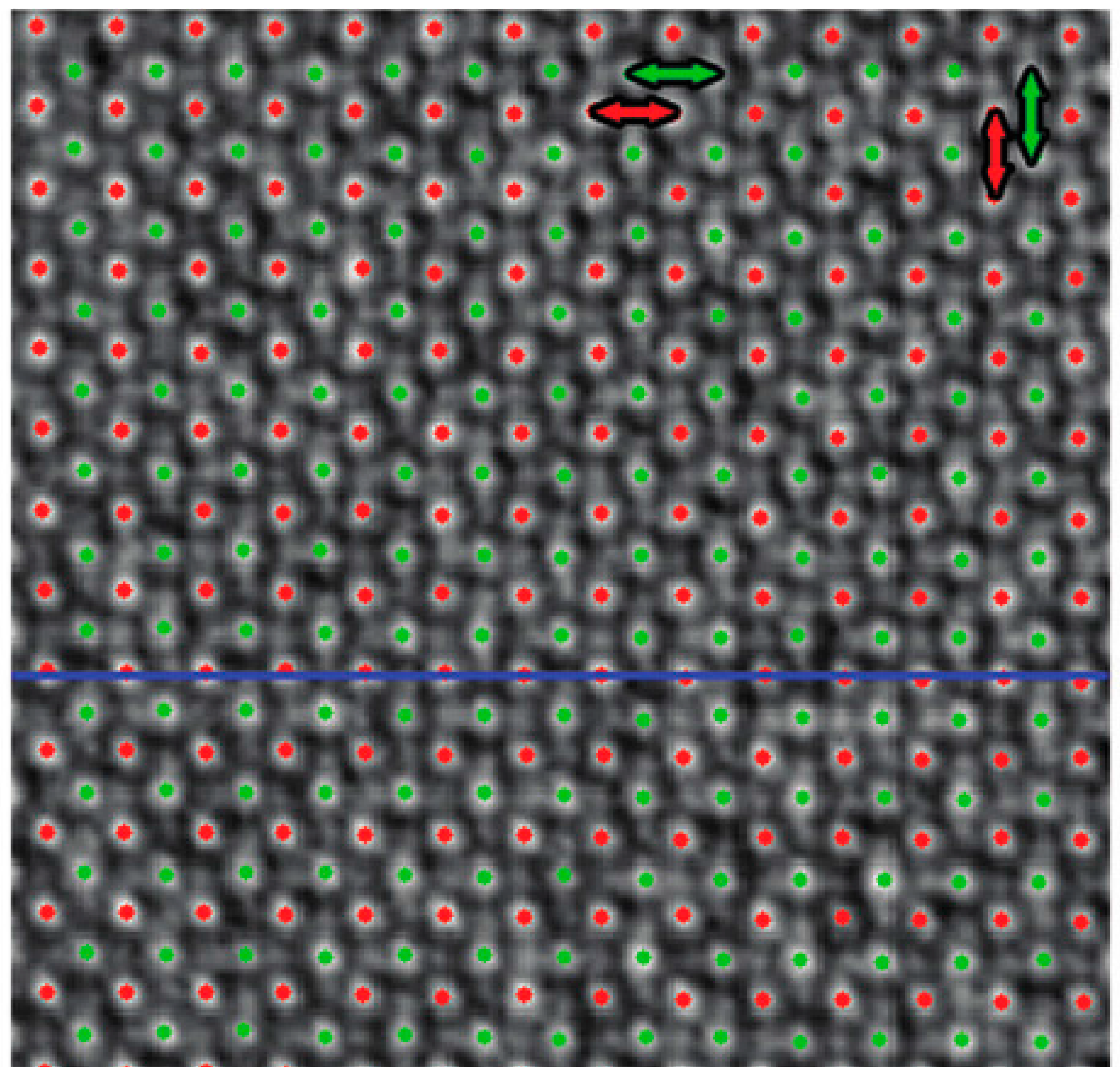
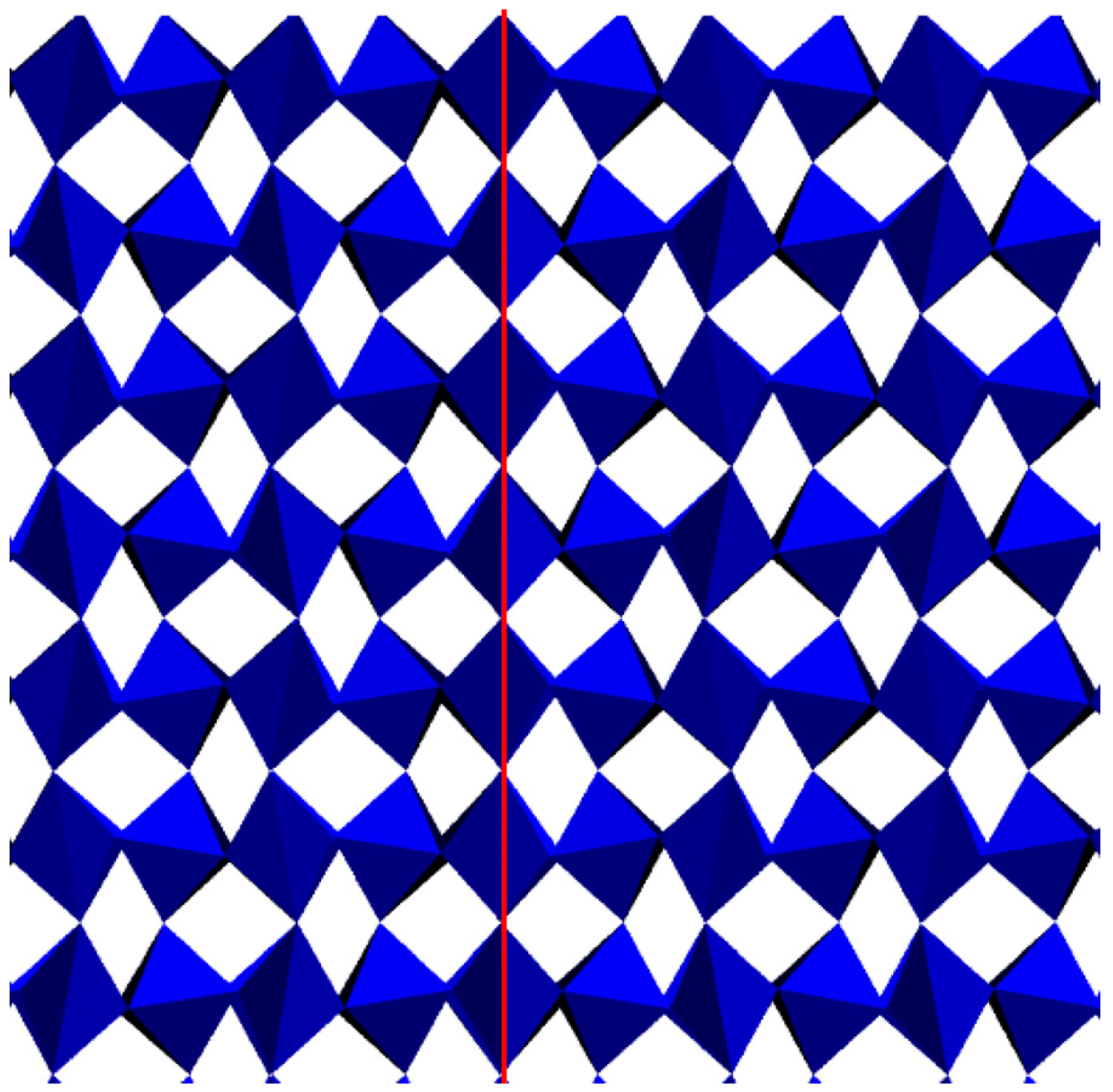
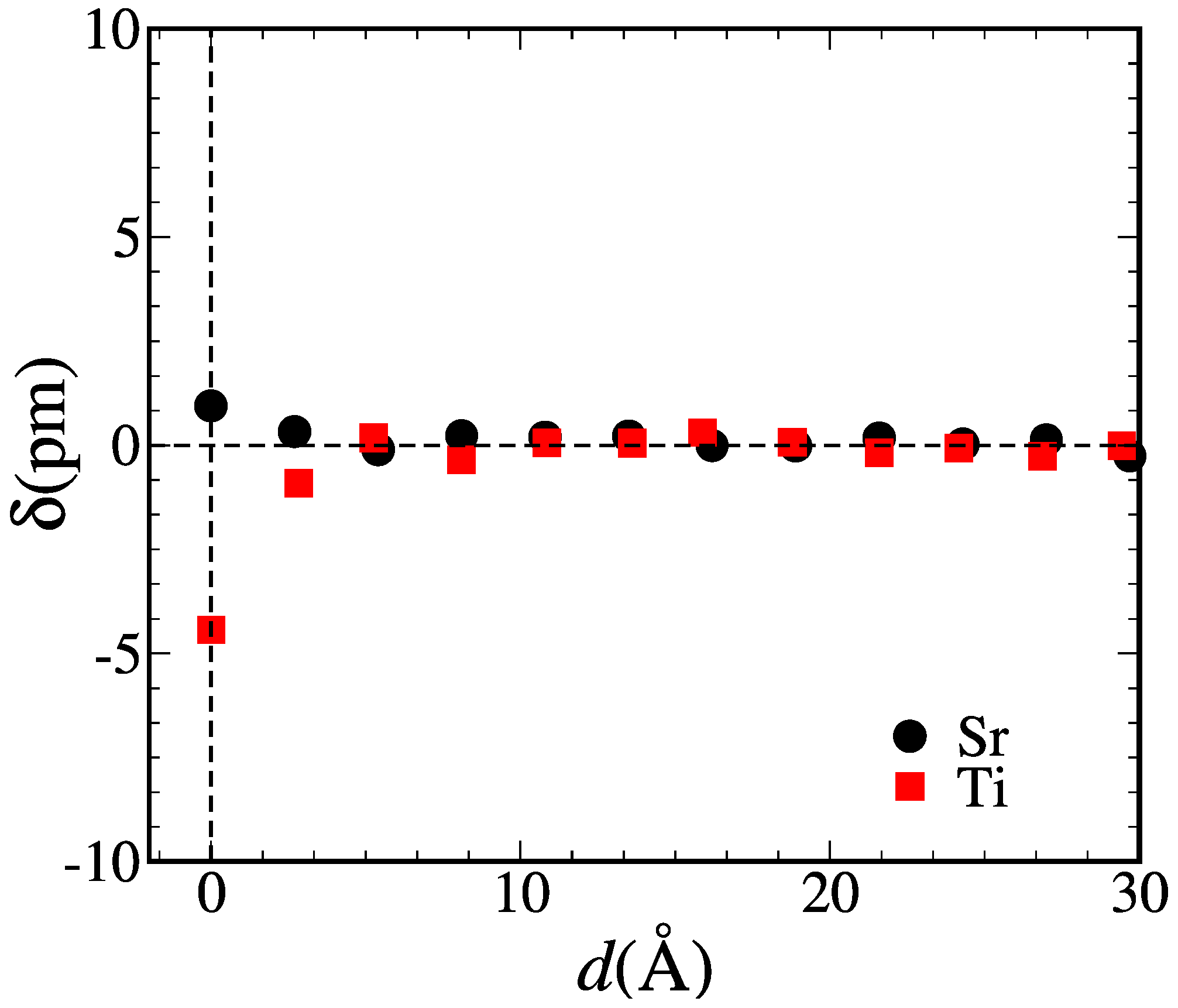
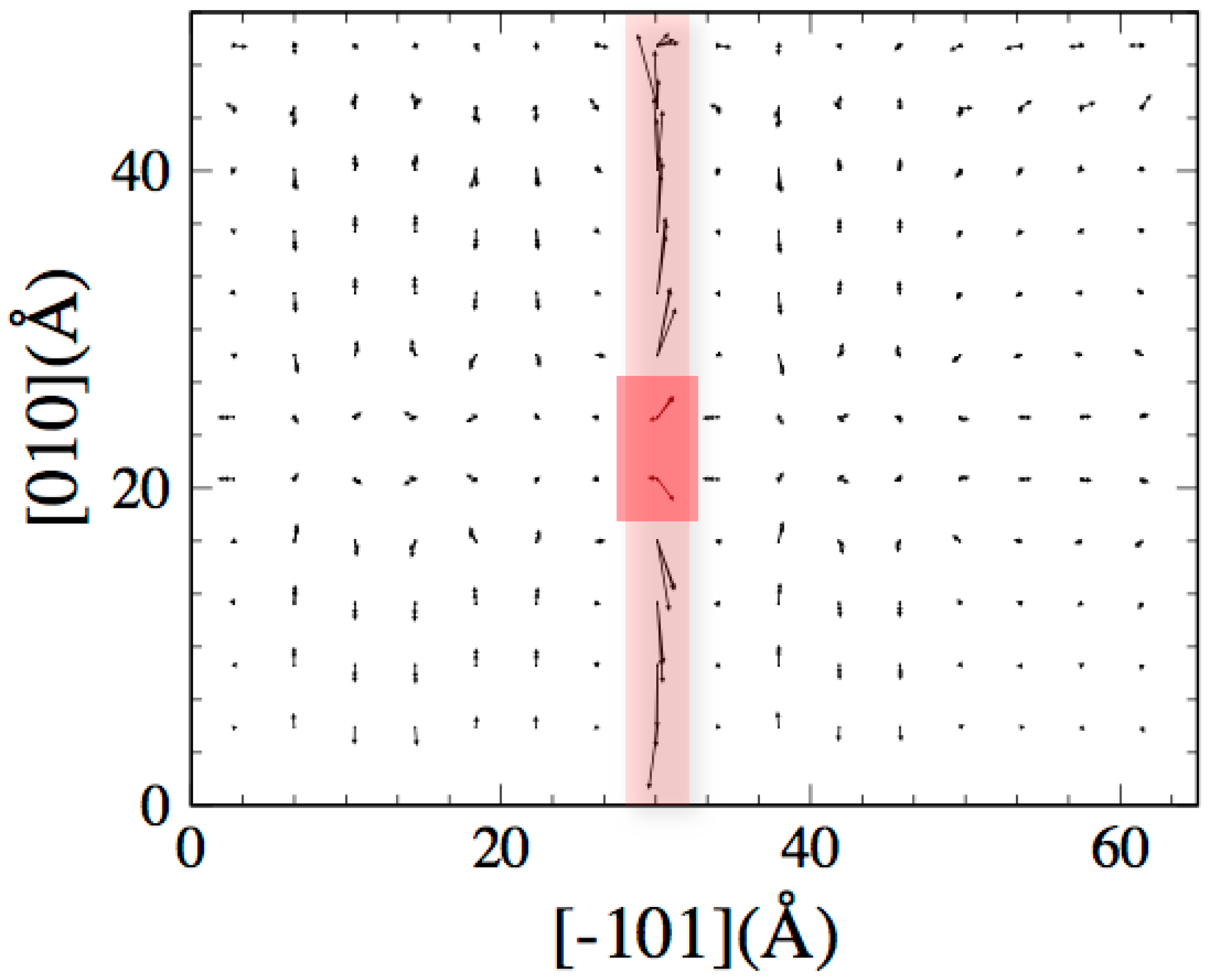
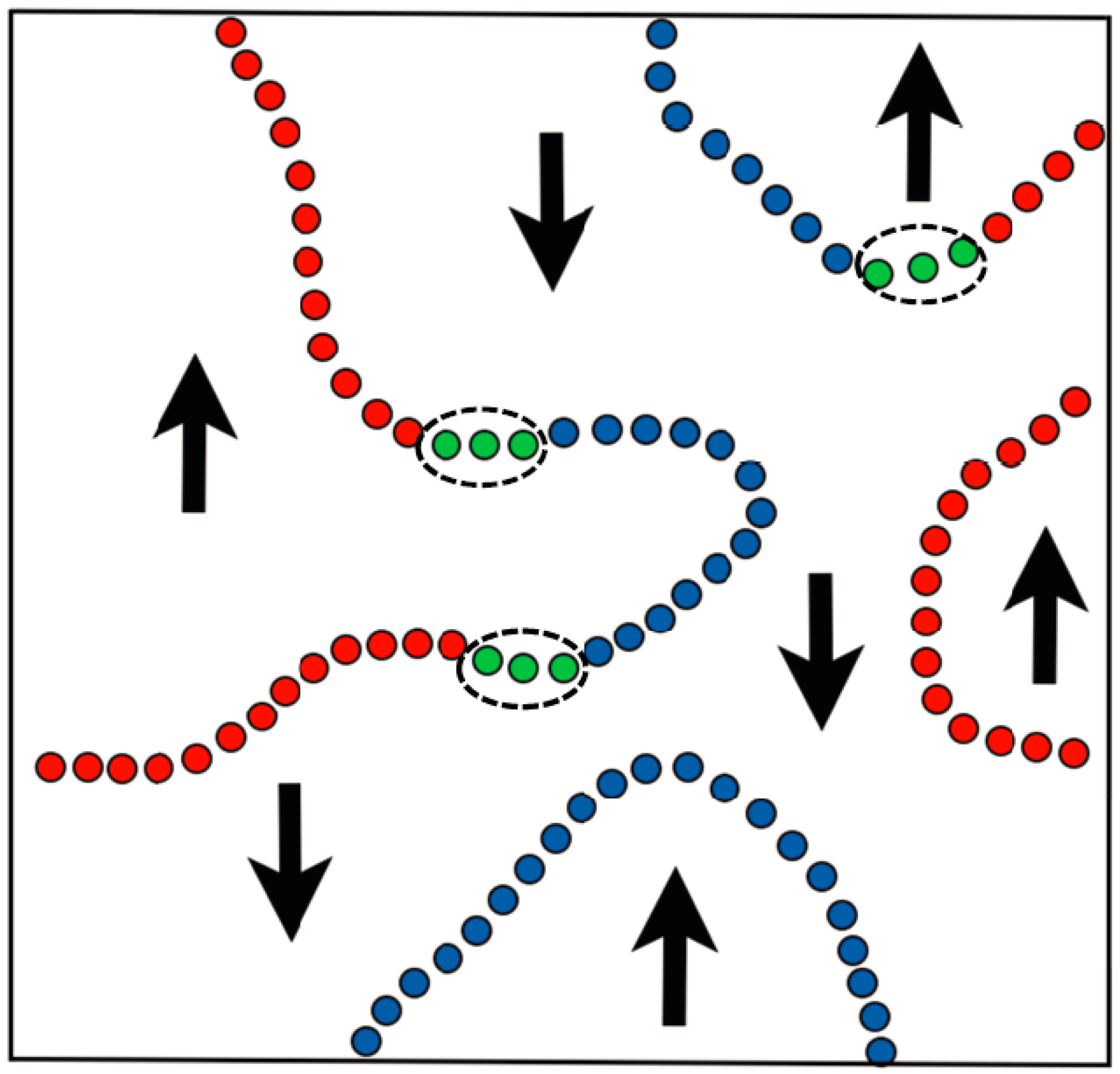
© 2016 by the authors; licensee MDPI, Basel, Switzerland. This article is an open access article distributed under the terms and conditions of the Creative Commons Attribution (CC-BY) license (http://creativecommons.org/licenses/by/4.0/).
Share and Cite
Salje, E.K.H.; Ding, X. Ferroelastic Domain Boundary-Based Multiferroicity. Crystals 2016, 6, 163. https://doi.org/10.3390/cryst6120163
Salje EKH, Ding X. Ferroelastic Domain Boundary-Based Multiferroicity. Crystals. 2016; 6(12):163. https://doi.org/10.3390/cryst6120163
Chicago/Turabian StyleSalje, Ekhard K. H., and Xiangdong Ding. 2016. "Ferroelastic Domain Boundary-Based Multiferroicity" Crystals 6, no. 12: 163. https://doi.org/10.3390/cryst6120163




